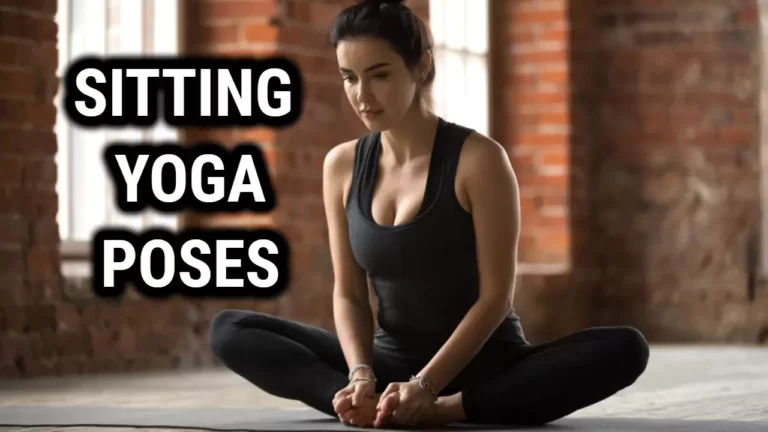Is Yoga Better Before or After Workout – Finally Answered

The age-old debate of whether yoga should be done before or after a workout is one that has been around for centuries. But with the advent of modern science, it has become easier to investigate the truth behind these theories and find out what works best for each individual.
We will explore the benefits of doing yoga either before or after a workout, in order to determine which option would be most beneficial for you as an individual.
The practice of yoga is said to have originated over 5000 years ago; however, its popularity has grown exponentially in recent years due to its numerous benefits.
Yoga helps improve flexibility and balance while calming the mind and body at the same time. Many people are now using it as part of their regular fitness routine – but should it be done before or after a workout?
Benefits Of Doing Yoga Before A Workout

The practice of yoga before a workout can be an incredibly beneficial way to improve your physical performance and overall health. Pre-workout yoga can help warm up the body, increase blood flow, and prepare the muscles for exercise.
Stretching boosts blood flow to your muscles, which delivers nutrients and oxygen, initiating the repair process of your muscles. Doing yoga before a workout can also help reduce stress, sharpen focus, and provide practitioners with more energy and endurance.
Physical health benefits are not the only advantages of doing pre-workout yoga; it can also provide psychological benefits such as improved focus, increased productivity during workouts, and enhanced sense of well-being.
Practicing mindful breathing techniques during pre-workout yoga can also help to boost mental clarity and focus on the task at hand. Additionally, taking time to relax and clear the mind before a workout can help reduce stress levels which will in turn result in improved physical performance.
Practicing yoga before a workout is an effective way to warm up your body for exercise while simultaneously providing both physical and psychological benefits.
Not only does it help to improve flexibility and reduce stress levels but it also helps to increase energy levels and enhance concentration. With all these advantages, it is no wonder why incorporating pre-workout yoga into any routine has become so popular.
By combining mindful stretching with dynamic movements, practitioners can create a balanced routine that will prepare them for their next gym session or other activity.
Benefits Of Doing Yoga After A Workout
1. Relieves Stress: Doing yoga after a workout can be a great way to relax and de-stress. The stretching can help to release endorphins which can help to relieve stress and improve mental clarity.
2. Improves Posture: Doing yoga can help to correct posture and improve alignment. This can help to improve balance and keep the body in proper alignment.
3. Increases Blood Flow: Doing yoga can help to increase blood flow to the muscles. This can help to reduce inflammation and improve muscle recovery.
4. Improves Balance: Doing yoga can help to improve balance and coordination. This can be beneficial for those who participate in sports or activities that require balance and coordination.
Doing yoga after your workout or before both ways it will give you equal benefits.
Warm-Up And Its Effects On The Body

Warming up before a workout is an essential part of any exercise routine. It helps to prepare the body for the physical demands of the activity and can prevent injury. A warm-up typically consists of dynamic movements such as jogging, light aerobic exercises, or dynamic stretching.
Dynamic stretching involves active movement of the joints and muscles in order to raise core temperature and release tension. This type of movement is especially beneficial before activities that involve power, speed, and agility such as running or weightlifting.
Pre-workout static stretching has long been debated in terms of its effectiveness before exercise. While some believe that static stretching can be used to warm up prior to activity, others believe it should be avoided due to decreased performance and increased risk of injury.
Static stretching involves holding a stretch for 10-30 seconds without any movement; it does not elevate core temperature like dynamic movements do. Therefore, it’s best used after a workout when your muscles are already warmed up.
Incorporating yoga into a workout routine offers many benefits regardless if done before or after exercise. The combination of static and dynamic stretches with mindful breathing techniques can not only help you feel better physically but mentally as well.
Benefits Of Incorporating Yoga Into A Workout Routine
Adding yoga to your workout routine can have a variety of positive effects on your overall health and well-being. For example, one study looked at the benefits of incorporating a regular yoga practice into the daily lives of twenty office workers.
After just four weeks, the subjects reported feeling better mentally and physically, with improved concentration, increased energy levels, and improved physical flexibility.
The benefits of adding yoga to your workout routine extend beyond just physical gains. Yoga helps to promote healthy breathing techniques which can help reduce stress hormones in the body and promote relaxation.
It also helps strengthen mental clarity and focus as you become more aware of your movements and breath during practice. Moreover, because yoga is often low impact, it can serve as an effective warm-up or cool down activity before or after other exercises.
There are many reasons why incorporating yoga into a workout routine is beneficial for both physical and mental health. Not only does it help improve strength, flexibility, and balance but it also promotes mindfulness and relaxation, allowing practitioners to reap both physical and psychological rewards from their practice.
Yoga Poses For Gym Workouts

Now that you know the benefits of before and after yoga, let’s take a look at some specific yoga poses that may be beneficial when incorporated into a gym workout routine.
Whether you are looking to improve your physical performance or simply wish to start incorporating more mindful stretching into your fitness routine, these poses can help you get the most out of your workout.
Before beginning any kind of physical activity, it is important to warm up in order to prevent injury and maximize performance. Incorporating yoga poses into a warm-up routine can help to increase blood flow and prepare the body for exercise.
These poses can also be used in between sets or as part of a cool down routine at the end of a workout. Here are some helpful yoga poses for gym workouts:
Warming Up:
- Cat/Cow
- Downward Facing Dog
- Child’s Pose
- Strengthening:
- High Plank
- Low Plank
- Warrior I & II
Cooling Down:
- Seated Forward Bend
- Reclined Twist
- Corpse Pose
By doing yoga before or after workout, you can increase flexibility, reduce stress levels, and improve overall performance during any type of physical activity. With this in mind, let’s now take a look at whether taking a yoga class before or after the gym is best for maximizing results.
Also Read: Standing Yoga Poses: Improve Balance and Flexibility with These Simple Moves
Taking A Yoga Class Before Or After The Gym?
If you are looking to improve your physical performance like cardio, taking a yoga class before your workout may be beneficial. By incorporating stretches and poses that target specific muscle groups, you can increase flexibility and range of motion in those areas, which can enhance performance during your gym session.
Furthermore, doing yoga before your workout can help to reduce stress levels and get you in a positive head space so that you are better able to focus on your exercise routine.
On the other hand, if you are looking for more of a mindful experience or simply wish to wind down after an intense gym session, then taking a yoga class afterwards might be best for you. Doing post-workout yoga can help to loosen tight muscles and improve circulation throughout the body. It can also provide an opportunity for mental reflection and relaxation following an intense workout session.
No matter which option you choose, there is no denying that taking a yoga class – either before or after hitting the gym – can provide numerous physical and mental benefits. Helping with improved performance and relaxation, it can also give you an excuse to stay active even when you don’t feel like exercising!
Frequently Asked Questions
How Much Time Should I Spend On Yoga Before Or After A Workout?
The question of how much time to spend on yoga before or after a workout is an important one. To make sure we are getting the most from our exercise routine, it’s essential to understand the benefits of yoga in relation to other activities.
Yoga is an excellent way to supplement any workout routine. It can help improve flexibility and strength while also calming the mind and body. The combination of physical and mental benefits makes yoga ideal for those looking to maximize their time working out.
Furthermore, it can be beneficial for people who have limited access to gym equipment due to its low-impact nature.
Ultimately, deciding how much time you should dedicate to yoga depends on your individual needs and goals. If you’re trying to focus more on physical fitness, then a few minutes before or after a workout may suffice; however, if you’re looking for a more holistic approach then longer sessions may be necessary. Either way, it is important to remember that regular practice will bring greater rewards than sporadic bursts of activity.
What Are The Best Yoga Poses To Do Before Or After A Workout?
Yoga is an increasingly popular exercise activity that can be done before, during, or after a workout. The poses used in yoga can help to stretch and strengthen the body, which can make it an ideal choice for any fitness routine.
However, deciding which yoga poses are best to do before or after a workout can be difficult. This article will explore the various options available for pre- and post-workout yoga sessions.
The type of yoga poses you choose to do before or after a workout depends on your individual goals. If you’re looking for a quick way to warm up or cool down after a high-intensity workout, then sun salutations are an excellent option.
These flows involve multiple poses that can help increase your heart rate and flexibility while improving your balance and agility. Alternatively, if you’re looking to relax and recuperate after a strenuous session, restorative poses like child’s pose and corpse pose might be more suitable for you.
No matter which type of poses you decide to practice before or after a workout, there are certain key benefits associated with each one. For example, holding forward folds helps to stretch out tight muscles in the back and legs while certain twists help to improve core strength and stability.
Moreover, some slow-paced yoga flows may be beneficial for calming the mind and releasing any lingering tension from the day’s activities.
In short, selecting the right type of yoga poses is essential for getting the most out of your pre- and post-workout routine. Whether it’s sun salutations for warming up or restorative poses for recovery afterwards, choosing exercises that best suit your individual needs is key to ensuring that you get the most out of each session.
Does Doing Yoga Before Or After A Workout Affect My Performance In The Gym?
Doing yoga before or after a workout is like a dance between two partners. It’s about finding the perfect balance between the two in order to get the most out of your fitness routine. So, does doing yoga before or after a workout affect your performance in the gym? Let’s take a closer look.
Yoga, when done correctly, can help to enhance your performance in the gym by improving flexibility and strength. If you are doing a full-body workout then it may be beneficial to do some dynamic stretching before you start to warmup your muscles and prepare them for activity.
On the other hand, if you are focusing on specific muscle groups, it could be more effective to do yoga poses afterwards as they will help with recovery and enable you to get back into shape faster.
No matter which option you choose, one thing is certain: incorporating yoga into your routine will benefit your workouts and give you an edge over those who don’t incorporate it. It can improve form and technique while reducing injury risk, as well as helping with regeneration so that you can maintain peak performance throughout your training program. So why not give it a try?
Are There Any Risks To Doing Pre-Workout Yoga?
First off, practicing pre-workout yoga may cause injury if done improperly. It is important to warm up your body before stretching or engaging in any strenuous activity, as failing to do so can lead to muscle pulls and strains causing muscle soreness and it will take several hours for your muscles to regain their ability to contract.
Too much stretching can be just as detrimental as not enough; overstretching muscles and ligaments can cause them to become weak and vulnerable to further injury.
To ensure safe and effective pre-workout yoga sessions: know your limits; don’t overstretch; practice poses that require less energy; and warm up properly before beginning any exercises or stretches.
Taking these steps will help minimize the risk of injury while still allowing you to reap the benefits of a relaxing pre-workout routine.
Related Read: Yoga Warm Up Poses For A Smooth Start
Conclusion
Yoga can be a great addition to any fitness routine, whether you do yoga before or after a workout. While the research is still out on exactly how much time should be devoted to pre- and post-workout yoga, it’s clear that incorporating some form of stretching into your routine will have positive benefits in terms of performance and injury prevention.
Additionally, there are plenty of other forms of pre-workout stretching you can do if yoga isn’t your cup of tea.
Ultimately, it’s up to each individual to decide what works best for them when it comes to incorporating yoga into their fitness routine. Whether you prefer to break a sweat before loosening up with some downward dog or wind down from an intense session with some deep breathing and meditation, one thing is certain: taking the time for yourself is never a bad idea.
To put it another way, don’t forget to make yourself a priority – otherwise you’ll soon find yourself stuck in an exercise rut or worse yet, sidelined with an injury.





